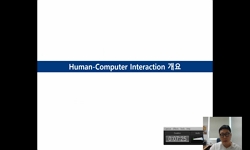본 연구에서는 Human - Artificial Intelligence Interaction(HAII)을 사용하여 사용자의 감정을 측정하기 위한 효과적인 프레임웍을 제안한다. 기존의 연구는 표본 조사 기반의 Human-Computer 인터페이스 평...
http://chineseinput.net/에서 pinyin(병음)방식으로 중국어를 변환할 수 있습니다.
변환된 중국어를 복사하여 사용하시면 됩니다.
- 中文 을 입력하시려면 zhongwen을 입력하시고 space를누르시면됩니다.
- 北京 을 입력하시려면 beijing을 입력하시고 space를 누르시면 됩니다.
https://www.riss.kr/link?id=A106254737
- 저자
- 발행기관
- 학술지명
- 권호사항
-
발행연도
2019
-
작성언어
Korean
- 주제어
-
등재정보
KCI등재
-
자료형태
학술저널
- 발행기관 URL
-
수록면
242-249(8쪽)
-
KCI 피인용횟수
0
- 제공처
- 소장기관
-
0
상세조회 -
0
다운로드
부가정보
국문 초록 (Abstract)
본 연구에서는 Human - Artificial Intelligence Interaction(HAII)을 사용하여 사용자의 감정을 측정하기 위한 효과적인 프레임웍을 제안한다. 기존의 연구는 표본 조사 기반의 Human-Computer 인터페이스 평가방법을 사용했지만 본 연구에서는 지능형 제품을 다루는 사용자의 생체 신호를 분석하고 생체 신호와 인간의 감정 사이의 관계를 분석한다. 추론된 모델은 실시간으로 사용자의 생체신호를 가지고, 지능형 제품을 사용하는 감정상태를 측정하는데 활용된다. 제안된 프레임웍의 효율성을 증명하기 위하여 Voice User Interface(VUI)를 가진 지능형 제품을 가지고 모델링하여 테스트를 진행한다. 31개의 뉴런 채널을 기반으로 한 뇌파 시스템(Electroencephalogram, EEG)에서 측정된 생체신호는 되며 K-최근접 이웃 방법 (K-Nearest Neighbors,KNN) 및 비선형의 서포트 백터머신(Support Vector Machine, SVM)알고리즘을 사용하여 분류된다. 제안 하는 프레임웍은 실시간으로 HAII 인터페이스 환경에서 인간의 감정을 측정하는 새롭고 효과적인 프레임웍으로 고려된다.
다국어 초록 (Multilingual Abstract)
This research suggests an effective framework for measuring user’s emotions in handling a intelligent production using Human-Artificial Intelligence Interaction (HAII). While the existing research studies used survey based human-computer interface e...
This research suggests an effective framework for measuring user’s emotions in handling a intelligent production using Human-Artificial Intelligence Interaction (HAII). While the existing research studies used survey based human-computer interface evaluation methods, this research analyzes the bio-signals of a user handling an intelligent product and reasons the relationship between the bio-signals and the human emotions. The reasoned model is used for measuring human’s emotions handing an intelligent product only with bio-signals in real time. In order to show the effectiveness of the framework, experiments using an intelligent system with Voice User Interface (VUI) are modeled and tested. The bio-signals are measured from Electroencephalogram (EEG) based 31 neuron channel and these are classified with the premeasured human emotions using a K-Nearest Neighbors(KNN) and nonlinear support vector machine. The suggested framework is considered a new and effective framework measuring a human’s emotions in HAII interface environment in real time.
목차 (Table of Contents)
- 요약
- Abstract
- 1. 서론
- 2. 배경 및 기존 연구 고찰
- 3. Human-AI Interaction을 위한 평가 프레임웍
- 요약
- Abstract
- 1. 서론
- 2. 배경 및 기존 연구 고찰
- 3. Human-AI Interaction을 위한 평가 프레임웍
- 4. HAII 기반 생체신호 수집 방안 및 분류 학습
- 5. 결론 및 향후 연구
- References
참고문헌 (Reference)
1 노석범, "차분진화 알고리즘을 이용한 지역 Linear Discriminant Analysis Classifier 기반 패턴 분류 규칙 설계" 한국지능시스템학회 22 (22): 81-86, 2012
2 이수용, "시계열 자료의 데이터마이닝을 위한 패턴분류 모델설계 및 성능비교" 한국지능시스템학회 21 (21): 730-735, 2011
3 임용배, "변형된 MFCC를 이용한 전기부하 판별 방법" 한국지능시스템학회 27 (27): 543-551, 2017
4 김진배, "Type 2 Fuzzy Number를 가진 가우시안 커널 기반 비선형 SVM 프레임웍 및 구현" 한국지능시스템학회 27 (27): 373-381, 2017
5 Mou, Yi, "The media inequality : Comparing the initial human-human and human-AI social interactions" 72 : 432-440, 2017
6 Corinna Cortes, "Support-vector networks" 20 (20): 273-297, 1995
7 김민영, "Simultaneous Kernel Learning and Label Imputation for Pattern Classification with Partially Labeled Data" 한국지능시스템학회 17 (17): 10-16, 2017
8 Farmer, Erick, "Review of workload measurement, analysis and interpretation methods" 33 : 1-33, 2003
9 Johnson, H, "Relationship between user models in HCI and AI" 141 (141): 99-103, 1994
10 Dirican, Ahmet Cengizhan, "Psychophysiological measures of human cognitive states applied in human computer interaction" 3 : 1361-1367, 2011
1 노석범, "차분진화 알고리즘을 이용한 지역 Linear Discriminant Analysis Classifier 기반 패턴 분류 규칙 설계" 한국지능시스템학회 22 (22): 81-86, 2012
2 이수용, "시계열 자료의 데이터마이닝을 위한 패턴분류 모델설계 및 성능비교" 한국지능시스템학회 21 (21): 730-735, 2011
3 임용배, "변형된 MFCC를 이용한 전기부하 판별 방법" 한국지능시스템학회 27 (27): 543-551, 2017
4 김진배, "Type 2 Fuzzy Number를 가진 가우시안 커널 기반 비선형 SVM 프레임웍 및 구현" 한국지능시스템학회 27 (27): 373-381, 2017
5 Mou, Yi, "The media inequality : Comparing the initial human-human and human-AI social interactions" 72 : 432-440, 2017
6 Corinna Cortes, "Support-vector networks" 20 (20): 273-297, 1995
7 김민영, "Simultaneous Kernel Learning and Label Imputation for Pattern Classification with Partially Labeled Data" 한국지능시스템학회 17 (17): 10-16, 2017
8 Farmer, Erick, "Review of workload measurement, analysis and interpretation methods" 33 : 1-33, 2003
9 Johnson, H, "Relationship between user models in HCI and AI" 141 (141): 99-103, 1994
10 Dirican, Ahmet Cengizhan, "Psychophysiological measures of human cognitive states applied in human computer interaction" 3 : 1361-1367, 2011
11 Jinbae Kim, "Pattern Recognition and Classifier Design of Bio-Signals collected in HAiI" 28 (28): 9-10, 2018
12 Kramer, Arthur F., "Multiple-task performance" 279-328, 1991
13 전왕수, "Fingerprint Pattern Classification Using Convolution Neural Network" 한국지능시스템학회 17 (17): 170-176, 2017
14 Bieger, Jordi, "Evaluation of general-purpose artificial intelligence: why, what & how" 2016
15 Chattopadhyay, Prithvijit, "Evaluating visual conversational agents via cooperative human-AI games" 2017
16 Kelley, John F, "An empirical methodology for writing user-friendly natural language computer applications" ACM 1983
17 López, Gustavo, "Alexa vs. Siri vs. Cortana vs. Google Assistant: a comparison of speech-based natural user interfaces" Springer 2017
18 Hernández-Orallo, José, "AI Evaluation : past, present and future"
19 Bernhard Boser, "A training algorithm for optimal margin classifiers" ACM 144-152, 1992
20 Cain, Brad, "A review of the mental workload literature" Defence Research And Development Toronto 2007
동일학술지(권/호) 다른 논문
-
오차 보상을 위한 보상기 기반 방사형 기저함수 신경회로망 분류기 설계
- 한국지능시스템학회
- 박상범(Sang-Beom Park)
- 2019
- KCI등재
-
지문매칭점수 분포의 데이터마이닝을 통한 새로운 매칭점수와 임계값 설정 방법
- 한국지능시스템학회
- 고영진(Yeong-Jin Goh)
- 2019
- KCI등재
-
- 한국지능시스템학회
- 김혜진(Hye-Jin Kim)
- 2019
- KCI등재
-
파라미터 불확실성을 갖는 이산시간 비선형 상호결합 시스템을 위한 강인 분산 제어기 설계
- 한국지능시스템학회
- 구근범(Geun Bum Koo)
- 2019
- KCI등재
분석정보
인용정보 인용지수 설명보기
학술지 이력
| 연월일 | 이력구분 | 이력상세 | 등재구분 |
|---|---|---|---|
| 2023 | 평가예정 | 재인증평가 신청대상 (재인증) | |
| 2020-01-01 | 평가 | 등재학술지 선정 (재인증) |  |
| 2019-12-01 | 평가 | 등재후보로 하락 (계속평가) |  |
| 2016-01-01 | 평가 | 등재학술지 선정 (계속평가) |  |
| 2015-12-01 | 평가 | 등재후보로 하락 (기타) |  |
| 2011-01-01 | 평가 | 등재학술지 유지 (등재유지) |  |
| 2009-01-01 | 평가 | 등재학술지 유지 (등재유지) |  |
| 2008-02-20 | 학술지명변경 | 한글명 : 한국퍼지및지능시스템학회 논문지 -> 한국지능시스템학회 논문지외국어명 : 미등록 -> Journal of Korean Institute of Intelligent Systems |  |
| 2008-02-18 | 학회명변경 | 한글명 : 한국퍼지및지능시스템학회 -> 한국지능시스템학회영문명 : Korea Fuzzy Logic And Intelligent Systems Society -> Korean Institute of Intelligent Systems |  |
| 2007-01-01 | 평가 | 등재학술지 유지 (등재유지) |  |
| 2005-01-01 | 평가 | 등재학술지 유지 (등재유지) |  |
| 2002-01-01 | 평가 | 등재학술지 선정 (등재후보2차) |  |
| 1999-07-01 | 평가 | 등재후보학술지 선정 (신규평가) |  |
학술지 인용정보
| 기준연도 | WOS-KCI 통합IF(2년) | KCIF(2년) | KCIF(3년) |
|---|---|---|---|
| 2016 | 0.62 | 0.62 | 0.63 |
| KCIF(4년) | KCIF(5년) | 중심성지수(3년) | 즉시성지수 |
| 0.56 | 0.49 | 0.866 | 0.2 |





 DBpia
DBpia







